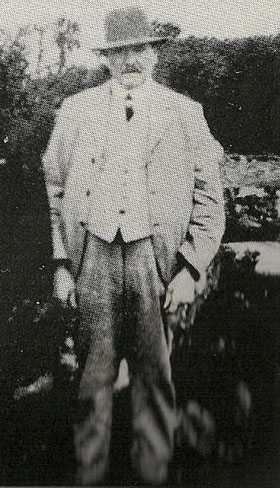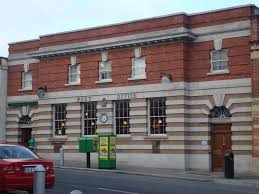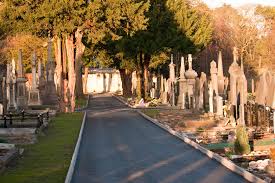Micheál Mac Ruaidhrí





Seanchai / Author / Poet / Patriot
This Mayo man was a friend of Ireland’s Eamon de Valera plus several noted politicians of his time. He contributed several admirable works despite his health issues.
Micheál Mac Ruaidhrí was born at Lower Foghill in northern Mayo. He was son of Seoirse Mac Ruaidhrí, his mother was Nancy Cooper. His grandfather Patrick Cooper was a teacher in Breastagh national school. (Anton McNulty The Mayo News 15th December 2020) [i]
According to Celine Naughton, Micheál was born with poor eyesight, he spent little time at school & could not read or write. He proceeded with determination to become one of the leading figures of the Gaelic revival in the closing years of the 19th century. As a child he visited local houses then listened to stories. [ii]
During his childhood, an accident resulted in severe blindness with the outcome that he received little education. He accrued knowledge of folklore, sagas, history music & song from local elder residents in his area. (McNulty ) [iii]
Micheál Mac Ruaidhrí was born in Lower Foghill near Kilcummin in Co. Mayo during 1860. His parents were Seoirse (George) & Nancy Cooper. His maternal grandfather Patrick Cooper was a teacher at the nearby Breastagh national school. He suffered with bad vision all his life following a childhood accident. According to this site he attended school on just two days. He amassed his vast knowledge of folklore, sagas, history plus music & song from elders in his area. He claimed that ‘he learned more from the oral tradition in his locality than he could ever do from a formal education.’ [iv]
Employment
Mac Ruaidhrí’s first employment on leaving Mayo was as a gardener at Stradbrook Estate in Blackrock, Dublin. This was followed by a teaching post of practical gardening with horticulture at Padraig Pearse’s original Ranelagh school. (McNulty ) [v]
Dublin
His friendship with Padraig Pearse began shortly following his Dublin employment as a gardener plus teacher of Irish language classes. (Celine Naughton) [vi]
Mac Ruaidhrí travelled to Dublin for employment as a gardener at Stradbrook Estate in Blackrock prior to his friendship with Padraig Pearse: (he bore a resemblance it appeared to Pearse’s late father) From the foundation of Pearse’s Cullenswood school in Ranelagh during 1908 Mac Ruaidhrí taught practical gardening & horticulture. [vii]
Marriage / Family Life
Padraig Pearse provided employment to Micheál tending to the school’s gardens at Rathfarnam. He also provided him with a house for his wife Alice & himself at the Gate Lodge following their wedding. Padraig Pearse’s sister Margaret hosted the wedding breakfast. They had a daughter Brighid who was born the following year; Margaret Pearse was her godmother. ‘From the age of ten, she used to sit at the table writing down her father’s stories, looking up now and then to gaze out the window, wishing she could be playing outside.’ Bridget remained at St. Enda’s Lodge when she married during 1946; she had four children, her fifth died as a baby. Bridget’s daughter Phil Lynch told Celine that she was the only girl at St. Enda’s. (Celine Naughton) [viii]
Micheál Mac Ruaidhrí married Alice Williams during 1911. They relocated with Padraig Pearse to ‘The Hermitage’ in Rathfarnham, Dublin the site of the St. Enda’s College. They resided in the Gate Lodge that became known as St. Enda’s Lodge. A daughter Brid was born during 1912. This girl from the age of ten transcribed her father’s stories that included his childhood memoirs; these were published as ‘Le linn m‘oige’ during 1944. (McNulty ) [ix]
With his new bride the former Alice Wallace; Micheál Mac Ruaidhrí during 1911 relocated with Pearse to Rathfarnham’s new St. Enda’s School called ‘The Hermitage.’ He lived at Gate Lodge (originally known as St. Lorcan’s School) later referred to as St. Enda’s Lodge. The school’s motto was ‘Truth on our lips, strength in our hands, and purity in our hearts.’ Apart from Science subjects all lessons were taught through the medium of the Irish Language. [x]
Irish Rising 1916
At the 1916 Easter Rising Micheál aged fifty-four spent a day at the G P O with Padraig Pearse & volunteers but ‘Pearse sent him home to look after his mother and sister, and his own wife and child.’ He was told to ‘look after the women.’ Following the Rising Micheál was arrested with other rebels, then detained in the Welsh Prison of Frongogh. There he taught his fellow inmates Irish also recited the rosary for them. (Celine Naughton) [xi]
Micheál Mac Ruaidhrí was committed to Irish freedom, he was a member of E Company, 4th Battalion, Dublin Brigade. Aged fifty-six years he matched with Padraig Pearse to Dublin’s G P O: he was one of the few Mayo men present when The Irish Proclamation was read on Easter Morning. Mac Ruaidhrí was ordered back to St. Enda’s (due to age & poor eyesight) with instructions to hide or destroy any secret documents. He was arrested as a rebel then imprisoned at Stafford Prison later at Frongogh internment camp in Wales. As the oldest prisoner his time passed as he provided history & Irish classes to his inmates. (McNulty) [xii]
In addition to the patriot brothers Patrick & Willie, Micheál Mac Ruaidhrí along with fifteen students from St. Enda’s participated in the Rising at the G P O. He was confined at Frongoch prison in Wales for his role in the activities. [xiii]
Publications
Under the pseudonym ‘Máthóg Ghuill’ Mac Ruaidhrí produced five publications in the Irish language. During 1903 he published Beatha Aodha Uí Néill followed in 1906 by Foilsiodh Breaga Eireann then in 1908 the Éan an Cheoill Bhinn. He penned during 1910 the following Lúb na caillighe then Mac Mic Iasgaire Bhuidhe Luimnighe which covered the folklore of North Mayo. He was a regular contributor to Padraig Pearse’s newspaper An Claidheamh Soluis. (McNulty) [xiv]
Awards
During 1901 Mac Ruaidhrí won an Oireachtas prize for his collection of proverbs. He was awarded seven gold medals in Feiseanna for Cainteoireacht or Óráidiocht. Several of his publications were prescribed texts for the Intermediate Certificate Exams also the National University. (McNulty) [xv]
Friendship
Following his release from prison Mac Ruaidhrí resumed his career as gardener but relinquished his role in politics. He returned to his writing with folklore collection activities. He became an oracle for his good friend Eamon De Valera, he enjoyed the company of Doughlas Hyde also folklorist Michael O Tiomaindhe from Laherdane. It was reported that Mac Ruaidhrí & O Tiomaindhe often sang together with their favourite song the ‘Fainne Geal an Lae.’ (McNulty) [xvi]
Following the signing of the Anglo-Treaty during 1922 Mac Ruaidhrí ceased his involvement in politics. He concentrated on his writing with further folklore collections. He became good friends with Eamon De Valera, Doughlas Hyde also Michael O Tiomaindhe. It was reported that Mac Ruaidhrí with O Tiomaindhe (two Mayo-born giants of Irish folklore) often performed together, their favourite song was the ‘Fainne Geal an Lae.’ to the melody of ‘The Dawning of the Day.’ [xvii]
Demise
Micheál Mac Ruaidhrí’s demise during 1936. On hearing the news, Eamon De Velera requested the coffin remain open until he paid his respects; when he arrived, he saluted Micheál. (Naughton) [xviii]
Micheál Mac Ruaidhrí’s demise occurred at his home St. Enda’s Lodge on 31st May 1936 when he was aged seventy-six years. He was buried in Dublin at Glasnevin Cemetery. (McNulty) [xix]
The demise occurred of Micheál Mac Ruaidhrí aged seventy-six years on 31st May 1936 at his home of St. Enda’s Lodge. He was buried in Glasnevin Cemetery, Dublin. [xx]
Tributes
Celine Naughton’s article for the Irish Independent newspaper 8th September 2015, stated that ‘He may have been uneducated. But he left behind a wealth of literature. folklore. poetry and stories. That’s a legacy not just for our family but for the whole nation to treasure.’ (Naughton) [xxi]
When informed of Mac Ruaidhrí’s demise the then Taoiseach Eamon De Valera requested of the family that the coffin should not have the lid put on until he had seen his old friend plus paid his respects, which he did by a march to the coffin then he proceeded to salute. (McNulty) [xxii]
Eamon De Valera, when informed of Mac Ruaidhrí’s demise requested the family not lid the coffin until he could see his old friend then pay his respects. He performed this with a march to the coffin also a salute. In later years, a memorial was erected at Foghill with a monument on the site of his birthplace. [xxiii]
Padraig Pearse admired him because of his ability to speak the Irish language also use it in prose. Prior to his execution Pearse penned a few lines of farewell:
Slán leat a Michal.
Slán leat go deo;
Slán leat a Mhicheal
As Condae Mhaigheo.’ (McNulty) [xxiv]
Journalist & author William Patrick described Mac Ruaidhrí thus: ‘In the mind’s eye of everyone who knows much of Gaelic Ireland… Micheál Mac Ruaidhrí is a vivid and racy personage. He overflows with character. He also overflows with North Connacht story and tradition and the Irish he speaks is particularly idiomatic & copious… No one would who takes grave & formal views of life would understand Micheál Mac Ruaidhrí’s place in Ireland. There is a flavour of wild earth & antique saga about him.’ (McNulty) [xxv]
Leader of the Irish volunteers & Irish language scholar Eoin O ‘Neill stated that ‘Mac Ruaidhrí was the greatest seanchaí of his time.’ (McNulty) [xxvi]
Irish language enthusiast & rebel Darrell Figgis penned in his A Chronicle of Jails that ‘At seven each morning after breakfast & at eight at night the bell was rung & we all gathered for public prayers. Mac Ruaidhrí, Irish orator & Padraig Pearse’s gardener led the rosary.’ (McNulty) [xxvii]
Doughlas Hyde referred to Mac Ruaidhrí as ‘The Mayo Poet’ due to the ‘musical quality of his Irish.’ [xxviii]
Former student at St. Enda’s College Desmond Ryan described the activities of Micheál Mac Ruaidhrí within the school as the school Seanachai that included his lectures on gardening. (McNulty) [xxix]
The article by Anton McNulty includes an image of Micheál Mac Ruaidhrí also an image of one of his publications Mac Mic Iascaire Buí. [xxx]
A poem was produced in Mac Ruaidhrí’s memory by a former pupil of St. Enda’s Niall Mc Neill. A jig ‘Between the Tides’ was composed by Dave Munnelly from Belmullet; it featured in the 2001 TG4 Documentary based on Micheál Mac Ruaidhrí’s life entitled ‘Solas sa nDorchadas.’ [xxxi]
In north Mayo on the way to Lackan Strand is a plaque dedicated to Micheál Mac Ruaidhrí a writer, poet, patriot & historian. [xxxii]
Nollaig Ó ‘Muraile referenced Micheál Mac Ruaidhrí in his article Dubhaltach Mac Fhirbhisigh and County Mayo (pages 1-21) published in the Journal of the Galway Archaeological & Historical Society vol 58 2006. [xxxiii]
Footnotes
[i] https://www.mayonews.ie/ [Assessed 17th December 2020]
[ii] Raised on songs etc (https://www.independent.ie/irish-news/raised-on-songs-and-stories-of-the-rising-31511595.html) [Assessed 17th December 2020]
[iii] https://www.mayonews.ie/ [Assessed 17th December 2020]
[iv] Foghill-Sacred Landscapes (http://www.sacredlandscapes.ie/foghill.html) [Assessed 17th December 2020]
[v] https://www.mayonews.ie/ [Assessed 17th December 2020]
[vi] Raised on songs etc (https://www.independent.ie/irish-news/raised-on-songs-and-stories-of-the-rising-31511595.html) [Assessed 17th December 2020]
[vii] Foghill-Sacred Landscapes (http://www.sacredlandscapes.ie/foghill.html) [Assessed 17th December 2020]
[viii] Raised on songs etc (https://www.independent.ie/irish-news/raised-on-songs-and-stories-of-the-rising-31511595.html) [Assessed 17th December 2020]
[ix] https://www.mayonews.ie/ [Assessed 17th December 2020]
[x] Foghill-Sacred Landscapes (http://www.sacredlandscapes.ie/foghill.html) [Assessed 17th December 2020]
[xi] Raised on songs etc (https://www.independent.ie/irish-news/raised-on-songs-and-stories-of-the-rising-31511595.html) [Assessed 17th December 2020]
[xii] https://www.mayonews.ie/ [Assessed 17th December 2020]
[xiii] Foghill-Sacred Landscapes (http://www.sacredlandscapes.ie/foghill.html) [Assessed 17th December 2020]
[xiv] https://www.mayonews.ie/ [Assessed 17th December 2020]
[xv] Ibid
[xvi] Ibid
[xvii] Foghill-Sacred Landscapes (http://www.sacredlandscapes.ie/foghill.html) [Assessed 17th December 2020]
[xviii] Raised on songs etc (https://www.independent.ie/irish-news/raised-on-songs-and-stories-of-the-rising-31511595.html) [Assessed 17th December 2020]
[xix] The Mayo News 2020
[xx] Foghill-Sacred Landscapes (http://www.sacredlandscapes.ie/foghill.html) [assessed 17th December 2020]
[xxi] Raised on songs etc (https://www.independent.ie/irish-news/raised-on-songs-and-stories-of-the-rising-31511595.html) [Assessed 17th December 2020]
[xxii] https://www.mayonews.ie/ [Assessed 17th December 2020]
[xxiii] Kilcummin a Journey (https://www.northmayo.ie/kilcummin-a-journey-through-time-and-beauty-in-mayo-north/) [Assessed 17th December 2020]
[xxiv] https://www.mayonews.ie/ [Assessed 17th December 2020]
[xxv] Ibid
[xxvi] Ibid
[xxvii] Ibid
[xxviii] Ibid
[xxix] Ibid
[xxx] Ibid
[xxxi] Foghill-Sacred Landscapes (http://www.sacredlandscapes.ie/foghill.html) [Assessed 17th December 2020]
[xxxii] Kilcummin a Journey (https://www.northmayo.ie/kilcummin-a-journey-through-time-and-beauty-in-mayo-north/) [Assessed 17th December 2020]
[xxxiii] Dubhaltach Mac Fhirbhisigh (https://www.jstor.org/stable/i20720141) [Assessed 17th December 2020]







No Comments
Add a comment about this page